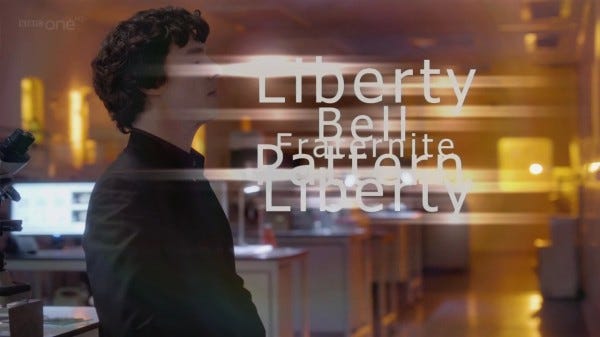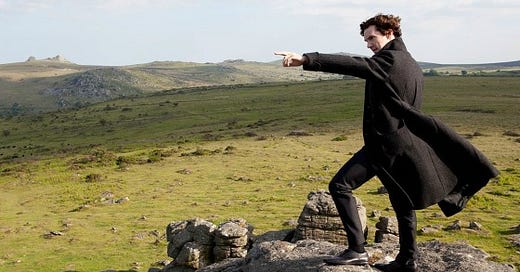I promised my paid patrons an extra special Wednesday post, and I’m giving you one within the theme of Monday’s post about adaptations on Doyle’s The Hound of the Baskervilles. This is the 5th in a long series of reviews that were originally published on now-inactive fansite of BBC Sherlock, called Sherlock’s Home. I did what we called “retrospective reviews” on each Sherlock episode from season 1 through season 3 (including extras and specials). I’ll be re-posting (not to be confused with riposting) each retro-review here on Wednesdays for paid readers only. And hey, who knows, maybe I’ll continue this series finally and do the retro reviews on season 4. /shudder/ Stay tuned, and enjoy my take on The Hounds of Baskerville.
SIDE NOTE: this website was UK-based, so you’ll notice my spelling is all British. (Adapted from Sherlock’s Home fansite, 2016)
Retrospective Review #5: The Hounds of Baskerville
Written by Prof. Jenn
As a reminder: I am writing these as RETROSPECTIVE reviews, so I will be discussing reveals, resolutions of cliffhangers, ends of plots, etc. If you are reading these reviews without having seen the eps, a) what is wrong with you?? Go watch them now! and b) these reviews are not for you till you’ve seen the episode in question.
…
This is one of the few Sherlock episodes that adheres mostly closely to one plot from one Doyle tale. In our case, it’s The Hound of the Baskervilles. Not that it’s exact, mind, but basic plot points, images, and several characters do echo the original. As far as the original goes, it’s a ghost or demon story that turns out to have a very basic greed-based motive, and the way [showrunner] Mark Gatiss has updated this concept is novel (ha–see what I did there?). After all, what else is a ghost story in today’s world but a conspiracy theory? From demon hereditary hound to deliberate genetic mutation seems a proper modernization, though now I think about it, they could have had a great time with a ghost-whisperer-type reality show…
The episode opens (well, post-prologue anyway) with a scene straight out of a lesser known Doyle story: “The Adventure of Black Peter,” wherein Holmes enters 221B covered in blood, with a harpoon. He has been testing it to see if it’s possible for a man to pin a body to a wall with one blow. Well, it’s never explained as such here, but that’s what it is in “Black Peter.”
We are treated to a client coming by to tell his tale (before Sherlock combusts with boredom), of having witnessed his father get killed by a “gigantic hound.” His name is Henry Knight, and is only the first of several characters named after their counterparts in the original novel. Sir Henry Baskerville is the dude in distress in the original, and here you can see the character’s knighthood echoed in his surname. What follows is an investigation in Dartmoor (also the setting of the original) of the hound sightings, and possibly nefarious doings of the Baskerville military science base. Some very fun and spooky action as well as good development of character makes this episode an enjoyable one to me, though I have heard many fans complain that it’s a weaker one.
To me, the only weak link in this chain is the character of Dr. Mortimer–she feels like such a throwaway character. I mean, what’s she doing allowing Henry to own a gun, let alone have it available during dangerous regression therapy sessions?! And all she can do when shot at by her patient is call a man she’s barely met (who isn’t even a psychiatrist) and beg him, in tears, to go find him for her? What a shoddy excuse for a professional…
Anyway, I thought it’d be fun for you all to see the many character and other names echoed from the original novel. It’ll hopefully give you a little extra insight to these characters, and also the intricate cleverness of Gatiss, who wrote this screenplay.
Henry Knight: already covered. Same young (well-off) protagonist.
Dr. Mortimer: the Baskerville family country practitioner in the original. “Mr. Holmes, they were the footprints of a gigantic hound” is a famous line of his that I’m glad was preserved in this ep in the mouth of a different character.
Corporal Lyons: surely named after Laura Lyons, a pivotal character in revealing the culprit.
Dr. Frankland: he’s just as blustery in the original, though in the original, he’s just Mr., and he actually isn’t the villain.
Dr. Stapleton: again, not Dr. in the original, Stapleton in the original is the owner of the hound and the killer of Sir Henry’s uncle as well as an attempted killer of Henry himself. Stapleton seems shady in this ep, and it’s a nifty bait-and-switch for those of us who know the original so well.
Major Barrymore: Barrymore is the similarly surly, bearded butler in the original. The Blu-Ray commentary tells us that the only reason he has a beard in this ep is to make him that similar to the original, as Army officials aren’t allowed facial hair.
The Great Grimpen Mine Field: just substitute “mine field” for “mire” and you’ve got a similarly dangerous stretch of the moor that you shouldn’t venture into, and that the villain ends up dying in.
Selden: when John investigates “UMQRA” he comes across a…shall we say, place for remote parking, and in one of the rocking cars we hear “Mr. Selden, you’ve done it again!” Selden is an escaped convict who roams the moor in the original.
There are many other nods and parallels to this and other originals (too many to recount), from Undershaw the meat suppliers to Sherlock’s silhouette on the tor, to the fake bet scene with Fletcher. This is another reason why I find this episode so enjoyable–it’s chock full of references.

FINAL NOTE: this is the first appearance of Sherlock’s Mind Palace, and apparently Cumberbatch’s gestures were improvised.
DOYLE EASTER EGG: when Sherlock is frantically looking for his cigarettes in the beginning, he grabs a slipper and quickly rummages in it before tossing it aside. In the original stories, Holmes famously keeps his tobacco in the toe of a Persian slipper. In series 3, we get a closer look at Sherlock stuffing cigarettes into said slipper, and it is indeed a curled-toed “Persian” type.
MODERN DAY EASTER EGG: John and Sherlock have a brief row over a previous game of Cluedo (Clue in the US), wherein Sherlock declares the only answer to the game’s mystery is that the victim did the killing himself, but that’s not within the rules of the game. However, in the real life Sherlock edition of Cluedo, the “Mr. Boddy” card is Moriarty. Since Moriarty killed himself, then indeed it is the game’s victim that did it!
Rating: 4 heaping spoonfuls of sugar in our coffee out of 5






I had no idea how many nods to the original story in this; thanks! I'll have to re-read and re-watch now!😁